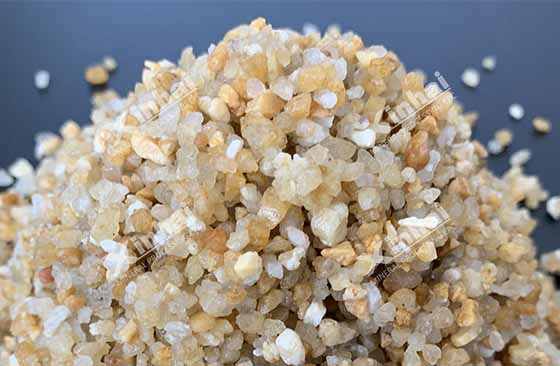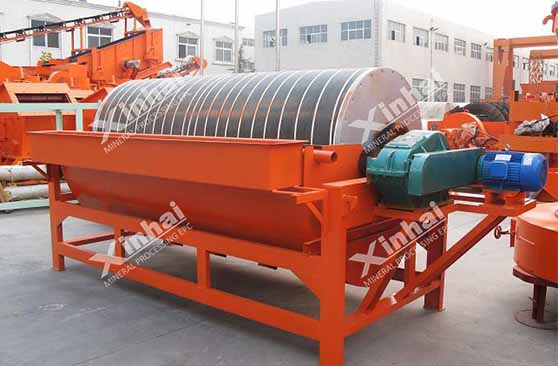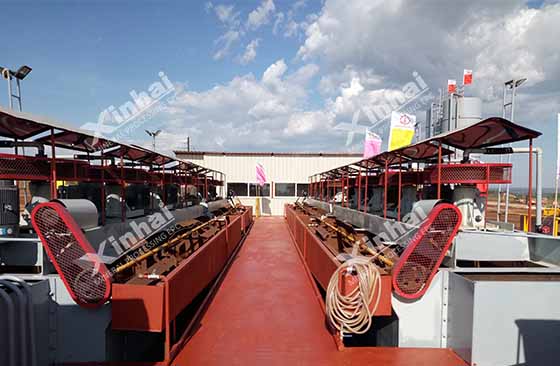

Warm Tip: If you want to know more details about equipment, solutions, etc, please click the button below for free consultation, or leave your requirements!
Quartz, also known as silica sand, is a non-metallic raw material with a wide range of applications. In quartz sand, the main mineral is quartz, and it often contains some other impurity minerals. Among them, the impurity minerals containing iron are: goethite, limonite, ilmenite, pyrrhotite, tourmaline, hornblende, biotite, etc. Some of these iron-containing impurities are embedded in quartz particles. Iron-containing impurities will cause great harm to the production and quality of glass. Therefore, it is very important to increase the grade of quartz sand and reduce the content of iron in the production process. The following will introduce several common methods for removing iron from quartz sand.

Mechanical scrubbing is to remove the thin film iron on the surface of quartz sand and the iron-bearing minerals adhering to the surface of quartz sand by means of mechanical external force and collision and friction between sand particles, so as to achieve the purpose of removing iron. It is generally believed that the main factors affecting the scrubbing effect are the structural characteristics and configuration of the scrubbing machine. Next is the process factors, including scrub time and scrub concentration. The efficiency of mechanical scrubbing increases with slurry concentration because increased slurry concentration increases the probability of collisions between particles. Compared with other iron removal processes, the process has the following characteristics:
The product quality is good, which can meet the quality requirements of float glass for high-quality silica sand
Large production
At present, some small-scale production enterprises and processing enterprises prefer to use this method to remove iron from quartz, because of its low cost and simple operation, but the iron removal rate is relatively low.
Quartz, the main mineral in quartz sand, is a diamagnetic substance and cannot be magnetized in magnetic field. In the quartz sand, iron-containing impurity minerals, such as hematite, limonite, magnetite, goethite, are mostly magnetic substances that can be magnetized in the magnetic field. In the magnetic separation process, this difference in properties is used to remove these iron-containing impurity minerals in the quartz sand.
Magnetic separation is divided into dry separation and wet separation. Wet high-intensity magnetic separation has defects such as large power consumption of magnetic separator, easy wear of medium, large production water consumption, high operation and maintenance cost and so on. Dry strong magnetic separation is easy to operate, and the operation and maintenance costs are lower than wet high-intensity magnetic separation.
In the magnetic separation process, the wet high-intensity magnetic separator can remove the weak magnetic impurity minerals such as hematite, limonite and biotite, including the contiguous particles. The iron removal effect of wet high-intensity magnetic separator is affected by parameters such as the amount of feed, the amount of flushing water, and the strength of the magnetic field, among which the magnetic field strength has the greatest influence. In addition, the more magnetic separation times, the finer the quartz sand particle size, the better the effect of iron removal.

Flotation method is mainly used to separate feldspar in quartz sand, but can also be used to remove clay minerals such as mica and secondary iron in quartz sand. The most typical process flow is to use hydrofluoric acid as the activator, amine cationic as the collector for flotation under strong acid conditions (pH 2 ~ 3). When iron flotation, NaOH can be used to inhibit quartz activated by metal ions. When flotation of feldspar, mica and other clay minerals, H2SO4 can not only produce localized adsorption on the surface of the feldspar being floated, reduce the surface electronegativity, but also activate feldspar and mica.
Flotation is very effective in removing iron from heavy minerals. A silica sand dressing plant in the United States used biodiesel and kerosene as collectors under acidic conditions to separate biotite and iron-bearing ores, reducing the Fe2O3 content from 0.12% to 0.18% to 0.06% to 0.065%. The flotation method has simple iron removal process, low cost and good effect.

Removing iron from quartz by acid leaching is to use the characteristics that quartz can't be dissolved in acid (except HF), and the impurity minerals containing Fe can be dissolved by acid solution, achieving the purpose of removing iron-containing minerals from quartz sand. Acid leaching can not only remove iron from quartz sand, but also remove non-metallic impurity minerals from quartz.
The harmful components of the quartz particles after flotation are connected to the surface in the form of spots or inclusions. To remove this part of impurities, acid leaching is necessary. The acids commonly used in acid leaching are sulfuric acid, hydrochloric acid, nitric acid and hydrofluoric acid, etc. The above acids are effective in the removal of Fe, Al and Mg. It was found that hydrochloric acid was better than sulfuric acid in removing iron.
The above are the current common process of removing iron from quartz sand. Different industries have different requirements for the content of SiO2 and iron in quartz sand. The suitable iron removal method can be selected according to the use and properties of quartz sand. Mechanical scrubbing method is simple, large production, but low iron removal rate. Magnetic separation and flotation are widely used, suitable for large-scale production, and the effect of removing iron is better. Acid leaching method has high cost and complicated process, and high purity quartz sand can be obtained. This method is suitable for the industry of high purity quartz sand products.
If you want to know more about quartz sand beneficiation information, or want to buy beneficiation equipment, you can consult our customer service or submit a message, we will contact you as soon as possible!
1Application of High Purity Quartz
 0
0
 3140
3140


What Are the Differences Between CIP and CIL?
 11220
11220
 0
0